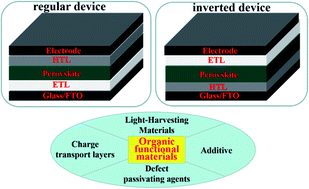Organic functional materials: recent advances in all-inorganic perovskite solar cells
Abstract
Although the power conversion efficiency (PCE) of organic–inorganic hybrid perovskite solar cells (PSCs) is comparable to those of commercial solar cells, a challenging problem of instability hampers their further commercialization. In recent years, in comparison with organic–inorganic hybrid PSCs, cesium-based all-inorganic perovskites show better light, moisture and especially thermal stability, and therefore they have exhibited great potential and received widespread attention. However, an unavoidable issue is that the PCE of all-inorganic PSCs still lags behind that of hybrid perovskite devices. To solve this problem, some organic or inorganic interlayer materials are introduced into all-inorganic PSCs as additive, passivation agent and charge transport materials to improve device performance. Compared to inorganic materials, organic materials present some advantages, such as energy level controllability, molecular structure diversity, and surface wettability modifications. Thus, the PCE of all-inorganic PSCs has been significantly improved through the use of organic materials. In this review, we summarized the recent strategies for improving the performance of all-inorganic PSCs through organic interlayer materials, including crystallization control, defect passivation, interface engineering, and expanding the light harvesting capability. Finally, a perspective on challenges and opportunities is proposed in the field.



 Please wait while we load your content...
Please wait while we load your content...